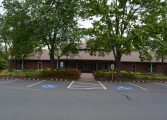By Page H. Gifford
Correspondent
In 2020, Horace Scruggs made a documentary on the history and life of Black churches in the area and the broader aspects of reconstruction after the Civil War. Scruggs worked with the Fluvanna County Historical Society and other area historians on the project, sponsored by the Virginia Humanities and supported by the Fluvanna Arts Council. The documentary will be presented on July 17, at 3 p.m. at the Fluvanna High School auditorium and is free to the public.
Scruggs said many of these Black communities are anchored by a church, most of them being independent Baptist churches and some lost to time. Others were located near the plantations where Black people were enslaved.
“The focus of this documentary is how after Emancipation and the Civil War how African-Americans began to reconstruct their lives after being torn apart by American slavery,” said Scruggs, adding that within a few short years, these newly freed Americans built churches, businesses, and schools. The areas he identified in Fluvanna are West Bottom, Shores, Cloverdale, and Thessalonia, the plantations where Blacks were enslaved. He added that some of these areas have not changed very much beyond common modernization. “The schools, mostly Rosenwald, have been abandoned or repurposed and the churches, though still active, don’t have the same attendance as before. In most cases, younger generations have moved to economic centers which is why it’s so important to tell these stories.”
Through his lens, Scruggs views how these Black communities were shaped by their inhabitants and the reason why they are still so close-knit today.
“Enslaved Americans came away from enslavement with very little. Their families were torn apart and the life they knew since birth was suddenly and violently changed. So, forming these communities was very important to their survival. Religious beliefs, education, and economic independence were all established in these rural spaces.”
He said he interviewed over 20 people for the documentary, each with their own perspective of history. Some shared church history and others their personal stories. Among them were Mozell Booker and Maxine Baskfield-Spears.
“I want this documentary to feature those who have lived in these communities, who attended these churches, learned in these schools, and who found some level of economic independence,” he said.
The churches in early times were the cornerstone of every neighborhood in cities and the centerpiece of every small town in rural areas.
“I learned that each church has a unique story but is connected by place, people, and time. Many family stories are entwined into the larger narrative of how these churches were started and sustained,” said Scruggs.
Baskfield-Spears remembers the beginnings of the Columbia Baptist Church on Rivanna Street in Columbia. “Many of our founders were community leaders and entrepreneurs. In 1870, these men were literate and were encouraging the same in the church members. They were very forward-thinking and progressive. One hundred years after its founding, the church is still home to descendants of the early parishioners.”
She enjoyed reminiscing with Scruggs. “As we sat in the sanctuary, I could almost feel the presence of the elders. I remembered the stories told by my grandfather of his years growing up in the church,” she said. “Two of the early pastors, the Rev. James Barrett and the Rev. John J. Richardson were his family members. The Rev. Robert Scott Huckless was my grandmother’s grandfather. The lives of the community members were intertwined with that of the religious community. Central to everything was the church on the hill.”
Baskfield-Spears welcomed the opportunity to share information about the Free Hill community that was located west of the town of Columbia and of many of the original members who were residents.
“So often we think history is only in textbooks. The reality is that it is in our local churches and our families. When we see the names on the page, we can feel the presence of those who came before us,” she said.
Mozell Booker summed up her memories of growing up in the Fork Union area with nostalgia we could all relate to. She was wistful as she talked about how schools and churches worked to encourage youth to develop their skills and talents.
“In church, we would sing and do plays and we had talent shows and in school as well and we had organizations, including Homemakers and Farmers of America,” she said. “It was a way to identify students and motivate them and give them opportunities.”
Dressing for Sunday church was important. Booker recalled her mother buying hats in Richmond, and one always wore gloves, and for some who could afford it, a small mink stole or Stone Martins, which were a status symbol for all women of the time. Men always had a handkerchief in their suit pockets.
“The men would gather and discuss problems in the Society Group. Adults never discussed these things in front of children.” Booker’s memories and similarities of generations past prompted her to say, “We are more alike than we are different.”
Baskfield-Spears added that, “I am so grateful for Mr. Horace Scruggs and his interest in capturing the history of our community. It is a legacy that must be preserved and I appreciate the opportunity to be a part of it.”
Scruggs said that, “for me, this has been an amazing journey into the core of what is African-American history for this county. So much of our identity, expression, experience, history, and culture is rooted in these community churches. And having the opportunity to explore and share this information is truly humbling.”




